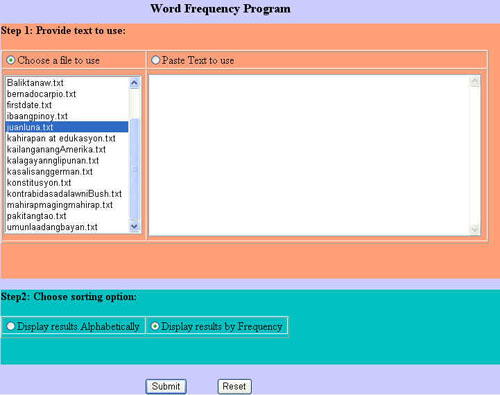
WORD FREQUENCY PROGRAM
Contents
Here we shall discuss two kinds of word frequency lists that are the separate outputs of the Word Frequency (WF) Program.
Numerical Word Frequency
This kind of WF list displays the high-to-low frequency of all of the words in the text(s) that have been processed by the WF software. (Read "How to
Use the Word Frequency Program"
in the next frame.)
A numerical frequency list has many uses, some of which include the following:
1. A pre-test of the lexical inventory of the
translator/student
After copying the WF
Program output into an Excel spreadsheet, a line count of the total number of
tokens in the text can be read by scrolling down to the bottom of the list.
The user/student can then check off the known words with an "x" for those that
are firm and/or a "?" for those that are under less firm
command. Experienced teachers claim that unless 95% of the lexicon of the
source text is under command of the
translator/student, the task of translating the entire text will quickly break down.
2. Content analysis
High frequency words, in
general, have many more meanings and grammatical or discourse functions than low
frequency words, e.g., "do" in English. A glance at high frequency words
can serve to reveal the contents of the text and can be used as a reading
readiness strategy to form a "schema" or hypothesis of what the source text is
all about.
Low frequency items are more often
than not candidates for dictionary look-up and of more importance to the
vocabulary acquisition of very advanced students.
3. Preparation of vocabulary-building exercises
If translation breakdown is real
or predictable, new strategies are called for: segmenting the text into smaller,
more manageable units and preparing vocabulary assignments, such as dictionary
and/concordance look-ups, flash cards, matching exercises, cloze tests, e-mail quizes (if available), using new words in sentences and so on. Some of
these assignments can be done individually or in groups, even using an on-line
discussion board facility.
4. Compilation of the student's own dictionary either by
opening up columns and rows in the Excel spreadsheet, or jotting down items in a
special notebook or word journal.
5. Online dictionary lookup by putting and pasting unknown words from the Excel
spreadsheet into an online dictionary for look-up and then pasting the found
translation back into the Excel spreadsheet.
6. Searching for a word in the text concordance to see
how it appears in all of its contexts. This is achieved by selecting the
word in the WF list, opening the "find" tool, pasting it into the "find" window
and clicking on the "find" button.
Alphabetical Word Frequency
The alphabetical word order listing has its own virtues. The most
obvious is that it assists the translator/student in looking up words in
dictionary order. In many cases words in this list, which are juxtaposed
in columnar fashion, can for certain Alphabetical WF lists are probably of more
utility for very advanced students with high reading and scanning competency.
Move the mouse over the parts of the image of the word frequency program below to get a brief explanation or read the instructions below.
The user can "provide text to use" in two ways:
1) choose a
text file from the left column of the window or
2) "select, copy, and paste" into the blank
space in the program window shown below a text from another source,
such as a news article
downloaded from the Internet.
In preparing Thai text for input, word boundaries will need to be inserted by
hand/space bar. Both programs can process only
Unicode fonts.
The segmented text should be saved for use in the concordance program or editing/correcting and re-sorting later.
At the bottom of the word frequency window shown below, the user can choose the sorting option
desired:
alphabetical or numerical.
The output time will vary from a few seconds to several minutes, depending on
the user's computer's processing speed and the size of the text..
The output list can be copied into an Excel spreadsheet by opening Excel on your
computer and then using "select + copy + paste" commands to move
the word list from the output of the WF program to the Excel spreadsheet, which
then can be saved for subsequent use.
